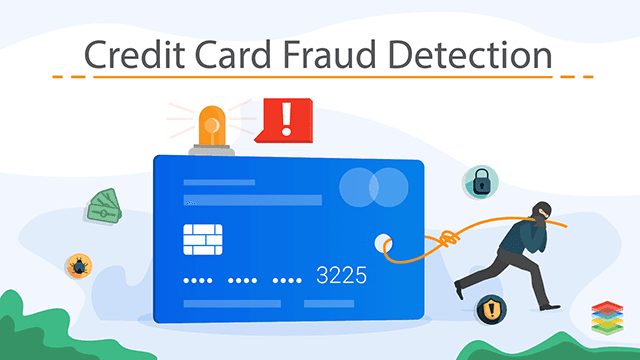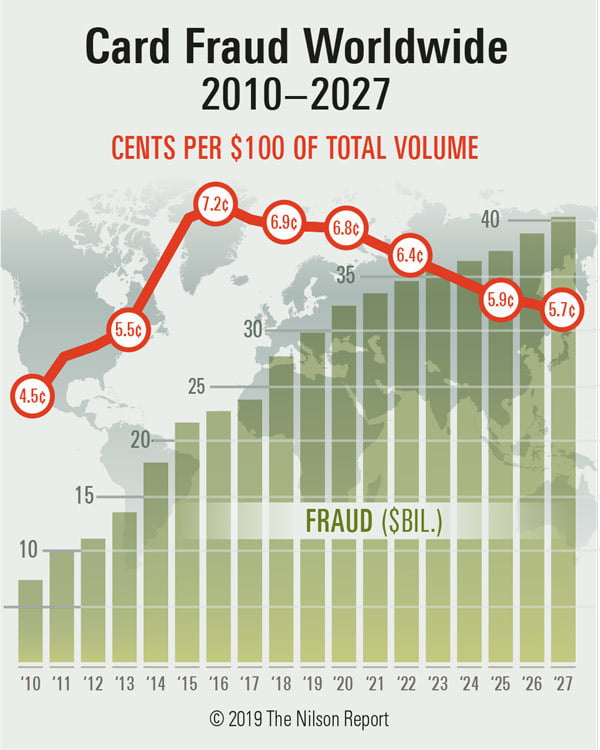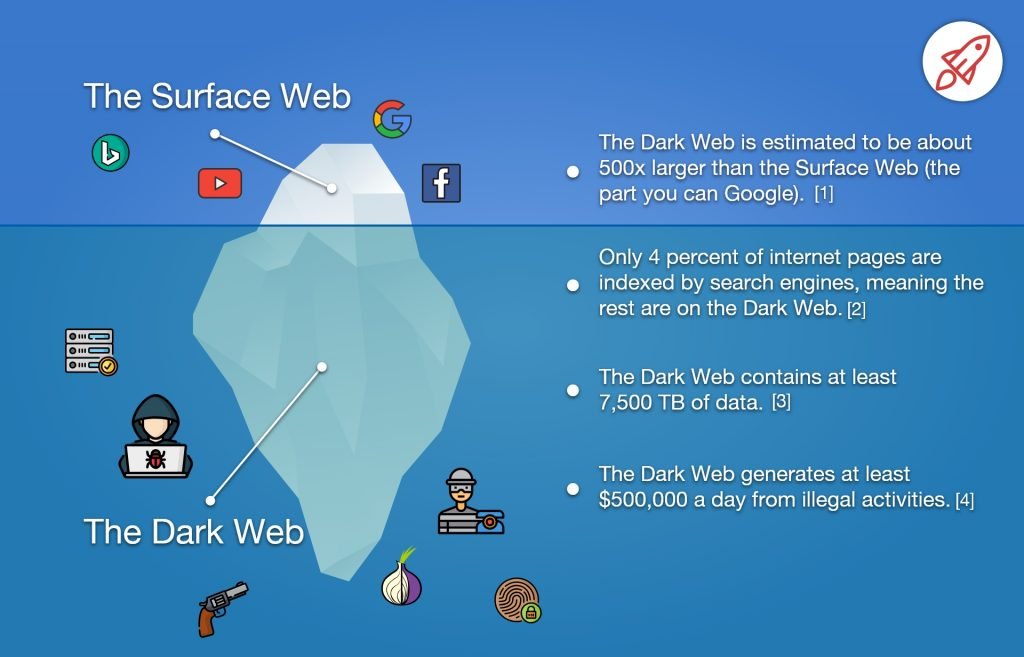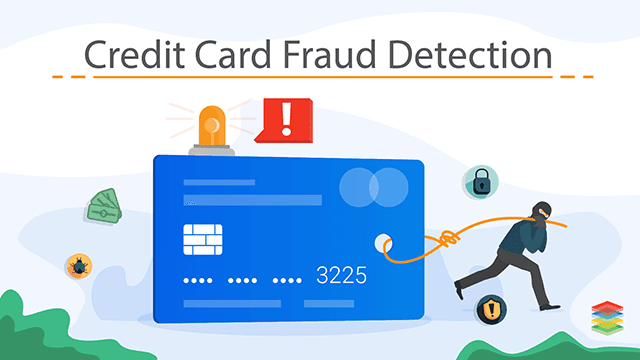
The Federal Reserve Payments Study shows that Americans use credit cards to spend $44.7 billion on average. Credit card usage is on the rise, but it has unintended consequences. According to the Nilson Report, credit card fraud has also increased. Global fraud losses reached $27.85 Billion in 2018 and are projected to reach $35.67 Billion by 2023.

What are the types of frauds committed with credit cards?
You can find a list of some common types and classifications for credit card fraud.
Stolen credit card:The thieves use the stolen credit cards to make fraudulent charges before the consumer is even aware of the scam.
Card-not-present fraudHackers can take control of a client’s account by using their credentials and then make online purchases. The physical card is not involved in this case.
Counterfeit Cards:Scammers used machines that read magnetic stripes to create duplicate cards. This type of fraud is now less common thanks to the EMV technology.
Intercepting Mailing CardsMany customers report that their credit card has been stolen out of their mailboxes.
Identity theft is a serious crime.The scammer will apply for the credit card in place of their victim and perform fraudulent transactions.
Credit card fraud: How to stop it with technology
While there are many Technology challenges for credit card fraudGovernment agencies and credit cards companies have joined forces to prevent credit card fraud. These technical tools can help prevent credit card fraud.
Card lock
The card locking facility is offered by many companies that offer credit cards. It allows users to make their plastic useless. This service is useful if your credit card gets lost or stolen.
The card locking feature can be activated using either a mobile application or through their online banking.
Discover is the company who introduced card locks to the market. It was called the “Freeze it feature”. Bank of America or Barclays is one of the many credit card companies that offer this feature.
Citi, Wells Fargo and American Express provide the service.
Verification of CVVs and AVS
This short, three-digit code can be found often on the back of credit cards. Hackers find it difficult to break the CVV code. It is easier to steal the credit number than the CVV.
AVS (Address Verification System) is a Fraud Prevention system that was introduced by Mastercard in order to combat CNP frauds (Card Not Present). AVS requires the user to enter the address when conducting an online transaction. The system compares the address entered with that in the records of the client’s bank. The bank then issues a code AVS to the payment system based on the comparison.
AVS and CVV both form an integral part of the multi-layered protection against fraud.
Dark web surveillance
Dark web is a collection of websites not indexable by popular search engines such as Google or Bing. Estimates suggest that the dark internet is 500 times as large as the surface web. These websites are off the radar of most internet users and hidden. It is here that internet criminals, such as credit card hackers, sell stolen data because it’s impossible to tell the origin of the upload.

Virtual credit cards numbers
Virtual cards can be powerful tools to curb spending. Credit card fraud is a cybercrime. Virtual credit card number is the link between the actual credit card and the virtual card. Virtual credit cards are quite different from real credit cards.
Virtual credit cards contain all of the same information as a real one, including expiration date and CVV. They are primarily used for online shopping and act as masks for credit card numbers.
Virtual cards are available for single transactions, but companies such as Eno offer alerts on suspicious transactions.
Visa, Discover Card, American Express and MasterCard have teamed up to offer a virtual credit card called “Click To Pay.”
A fraud score is a system that utilizes technologies such as Machine Learning to assess the likelihood of fraud. AI can be used to identify the probability of credit card fraud.
The algorithms constantly scan the data for any financial activity that is different from the normal behaviour of a client. When it detects an early sign of a fraud, the system alerts both the customer and bank officials.
Because they adapt themselves when scammers change their methods, Machine Learning systems can better detect fraud. Machine Learning protects users against fraud because of its adaptability. Online scams involving credit cards.
The digital wallet and contactless card
NFC (Near Field Communication), a technology that allows card issuers to provide contactless payment methods, is now available. Contactless payment methods can be an effective way to combat fraud. Online Banking Fraud They use a “tokenization” security system that allows the cardholder to complete the transaction with no need for the actual credit card number. Contactless credit cards contain an RFID chip that transmits information to the terminal.
Apple Pay uses NFC technology to facilitate their payment transactions. Users get an added layer of protection with their smartphones, as they can lock them with a pattern or face scan.
Mobile wallets are a popular way to transact, and everyone has heard of them as being one of most common modes during the current pandemic. Fraudsters have many methods to take advantage of digital or mobile wallet systems in order to steal the card data or the money. Digital wallets are vulnerable to fraud when registering a debit or credit card. If somebody manages to have physical access cards or any information–maybe fetched through data breach–they may get a way to register that card on their own digital wallet, even if the names on the cards are different. Digital wallet fraud is accomplished by bypassing the authentication checks on different platforms, even if the names do not match the IDs registered.
Credit monitoring
Most credit card providers offer free services of credit monitoring to help protect their customers from identity fraud.
As an alternative to credit monitor services, users can check themselves their card transactions regularly. Credit card companies usually offer apps and websites that allow users to monitor their credit card transactions.
Users can opt for additional security by using paid services such as Identity Guard, Privacy guard and Experian IdentityWorks.
Websites that store credit card data are restricted
Some websites require users to save their credit card details on the website. Users should be aware that while websites may boast about their robust security system, no system can guarantee 100% security. online fraud. To avoid hackers taking credit card information, it is best to not save the website’s data.
If entering credit card details every time you transact is a hassle, users can opt for payment services such as PayPal, Google Pay or Apple Pay. These are safe alternatives.
Subscribe to alerts
Users can protect themselves from fraud by signing up for alerts via email or phone. This feature is enabled by default for all credit card providers. They send alerts to users whenever their card makes a transaction. The users can notify the authorities immediately in the event that they find out they didn’t initiate the transaction. Reporting immediately allows authorities to stop trades, saving time and money in the long-term process of claiming back the money.
Geolocation
Visa mobile location confirm is a Visa service which allows Visa systems to track the user of a credit card using the smartphone. It ensures the cardholder is present physically at the location where the transaction takes place. Geolocation on credit cards eliminates frauds in which scammers access card data and make transactions online using the card user’s information, usually from somewhere else. Credit card companies add an extra layer of security to their credit cards by pinpointing the location of users.
CNP fraudsters test stolen card information. The CNP (Card Not Present) fraudsters test the stolen credit card data to see if they can trick the system into accepting a fraudulent transaction. If they are successful, they will quickly use up the entire balance of the card.
A velocity check is a good way to help protect users of credit cards from this type of fraud. It is important to note that the velocity checks monitor certain data elements which help fraud prevention systems detect fraud. It is the primary goal of these systems to assist merchants in identifying patterns that repeat themselves within a limited time.
When the same data is input multiple times in a short period of time, the velocity system can notify the authorities.
Here are the typical data elements that a system for velocity checking monitors
● User ID
● Billing address
● Phone number
● IP address
● Device ID
● Credit card number
● Email address
● Shipping address
Summary
Preventing fraudulent credit card transactions The question of how to use a credit card is one that plagues many users today. Users enjoy the convenience of a credit card, however it can be frustrating if they are a victim of fraud. Credit card users are empowered by smart systems to fight cybercriminals. Users can prevent credit card fraud by using fraud detection software and taking simple precautions.
